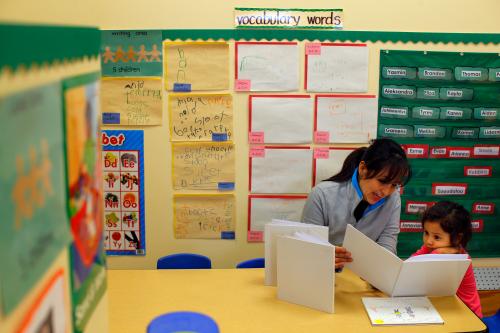This post is part of “Teacher diversity in America,” a series from the Brown Center on Education Policy that examines minority underrepresentation among public educators in the U.S.
Before the American Rescue Plan passed in March, steering nearly $130 billion into public school coffers, there was growing concern about the potential for widespread layoffs and what this might mean for the teacher workforce. Public school systems in two states began exploring policies that would prioritize teachers’ racial diversity over seniority in the event of layoffs. Worried that pandemic-induced budget shortfalls will lead to staff cuts that threatened to erase the progress on workforce diversity that many locales have seen in recent years, policymakers and leaders eyed pre-emptive action.
Even if it now appears that we’ve dodged the worst of what could have been—though the threat of layoffs will persist until we know student enrollments are coming back—it’s still constructive to consider whether this approach to protecting teacher diversity is worth preserving.
What is the policy considered here? Where layoffs typically rely on a last-in, first-out approach, prioritizing teacher diversity would shield nonwhite new hires from such actions. These policy decisions are broadly consistent with the growing evidence base on the value of teacher diversity in the workforce, which has been a central theme of our ongoing series. This is also the subject of Hansen’s new book from Harvard Education Press, along with co-authors Seth Gershenson and Constance Lindsay. In general, we applaud attempts to tackle this important issue and create more inclusive learning environments.
On the other hand, we view this approach of explicitly prioritizing racial diversity in layoffs as high risk and low return. It uses an approach that is legally fraught, and the eventual yield on diversity from targeting layoffs only is likely small. Instead, we argue that an approach that redefines teacher diversity as an element of teacher quality is lower risk and offers a higher return through an increased scope of applications.
The potential yield from only prioritizing diversity in layoffs is modest
Let’s start by contextualizing the teacher diversity problem and the expected benefits here. Based on the most recent national survey, just over 20% of the public teacher workforce identify as people of color, compared to just over 50% of the public student body. This amounts to a representation gap of about 30 percentage points, and evidence shows the benefits of a more diverse workforce to students of color are real and long-lasting.
Prioritizing diversity in the face of possible layoffs will only improve diversity to the extent that newly hired teachers are more racially diverse than the incumbent workforce in a district. Conversely, if new hires are demographically like those more experienced, there is little overall diversity to be gained by retaining nonwhite teachers. Thus, we can gauge the potential yield of such a policy by examining how the diversity of new hires compares to more experienced teachers.
Figure 1 shows the racial composition of teachers, broken out by experience categories. The most newly hired teachers (on the left) are evidently more racially diverse than those more experienced (on the right). These differences, however, indicate a slow evolution in diversity among new hires compared to veterans in the labor force, not a diversity revolution in recent years. The representation of nonwhite teachers increases by nearly 11 percentage points comparing the most experienced versus newly hired teachers. While these numbers may seem encouraging on the surface, note that these differences lag behind diversity trends observed in the broader workforce in recent decades. So, while there is a potential gain in diversity to be made during layoffs, the expected gain is modest.
There are also relevant implementation details that make us skeptical of the potential yield from prioritizing diversity during layoffs, without the accompaniment of other diversity-promoting policies. First, layoffs are generally rare occurrences in most locales—this strategy may help stave off losses of nonwhite recent hires during budget cuts but does nothing to elevate diversity outside of those contexts. Additionally, our prior analysis shows teachers of color tend to be clustered in schools serving high shares of nonwhite students. If white new hires are laid off first, at least some retained nonwhite teachers will need to be involuntarily transferred to even out staffing across schools, and these will likely be to very different contexts where they will be more racially isolated. Racial isolation is a factor associated with increased attrition among nonwhite teachers. Without additional supports for nonwhite teachers in these new settings, prioritizing diversity during layoffs could inadvertently accelerate their departure.
Explicitly prioritizing race is legally risky
Beyond the modest yield, using race as a criterion for deciding which teachers to keep will almost certainly attract a legal challenge. The closest case that has had a major legal decision on it is Piscataway Board of Education v. Taxman (1996), where the Third Circuit Court of Appeals sided with the case’s original plaintiff, Sharon Taxman, ruling that an ad hoc preference for racial diversity in teacher layoffs violated Title VII of the Civil Rights Act.
For those unfamiliar with the case, Piscataway Township Schools in New Jersey had to carry out a reduction in its teaching force in 1989 using a process specified in state law that prioritized teacher tenure and seniority. Coincidentally, Sharon Taxman and her teacher colleague, Debra Williams, were equally tied on all the prespecified criteria, leaving the ultimate decision to the school board. Breaking from precedent where perfect ties were decided through a random process, the board instead invoked the district’s affirmative action plan to retain Williams (who was Black) and lay off Taxman (who was white). The teachers’ races were relevant, the board later argued, as there were no other teachers of color in the department, though there were others in the school. The court’s ruling says the school board’s use of teacher race in making this decision was unlawful.
The takeaway here is that explicitly using teacher race in layoffs is legally fraught. It’s not clear why legislators feel justified in pursuing an analogous layoff strategy now. Perhaps they are confident because the case was never brought to the Supreme Court, and it isn’t a binding decision everywhere. Perhaps they feel that making such a preference systematic up front, rather than an ad hoc decision afterward, skirts the problematic elements of the case. Or perhaps they feel the merits of a similar case would be viewed differently now, 25 years later, particularly in the wake of last summer’s racial reckoning. Regardless of the rationale, adopting a policy in which racial diversity is explicitly prioritized is legally risky.
Redefine teacher diversity as teacher quality for higher reward, lower risk
Our main criticism with focusing on layoffs, though, is not that they have a relatively low yield and are risky. If we’re serious about promoting teacher diversity, we should be promoting representation and inclusion across many fronts—not just when reductions in the workforce are imminent.
A first step to making diversity count across many fronts is by redefining it as something that is already integral to school practices. Our recommendation: Redefine teacher quality to include teacher race. The rationale here, and further elaborated in Hansen’s book, is that we have more than enough empirical evidence to assert that exposure to teachers of color benefits students of color in meaningful and long-lasting ways.
Thus, teacher race warrants consideration alongside other measures of teacher quality—like experience, observational ratings, value-added measures, etc. In other words, as states and districts continue to monitor teachers’ performance in the classroom and students’ access to quality teaching, a teacher’s race should be just as critical as these other metrics in steering workforce policy and prompting action.
When teacher quality is redefined to consider teacher race, we are implicitly prioritizing diversity in any aspect of teacher policy where quality is considered. This means we not only prioritize diversity in layoffs (by making teacher quality the priority consideration), but we can also prioritize diversity in compensation policies, staffing and assignment policies, and any other policy area where teacher quality can be invoked and promoted.
We acknowledge that teacher race as an element of teacher quality dilutes the focus on race somewhat; however, this dilution is a critical step in making the policies legally defensible. We cannot directly prioritize teachers’ race or ethnicity, even as a tiebreaker criterion as in the Piscataway case. However, if we make the case that it is one of many markers of quality that benefit students, we can move forward with confidence on many policies prioritizing quality.
We should also note that not all measures of teacher quality will always agree, and that’s to be expected. Indeed, this is the reason why we argue for including teacher race as one of many dimensions of teacher quality; each measure signals something important, but no single measure is sufficient. Massachusetts recently saw this dynamic play out when it relaxed licensure requirements due to the pandemic and witnessed a surge in racially diverse teachers joining the workforce. Though long used as a single gatekeeper on entry into the profession, teacher licensure testing has received wide criticism as a racialized screen. Our view is that relaxing quality standards on the licensure dimension have enabled a flourishing on the teacher diversity dimension—a change that we expect will benefit many Massachusetts students.
Also, when we acknowledge teacher diversity is integral to teacher quality, we’ll take the necessary steps to preserve and foster it in places where it now struggles to survive. This means creating racially inclusive school environments in historically white settings, avoiding the adverse effects of racial isolation. This means we promote a diverse pipeline, like Minnesota’s Increase Teachers of Color Act provides funding to support new, diverse pathways into the classroom. And this means we take action to set goals and monitor diversity, like the Tennessee Board of Education’s new Educator Diversity Policy does.
Lastly, efforts to include teacher race as a dimension of teacher quality are even more important as we look forward to reopening after the pandemic. School closures over the past year led to substantial learning loss and an increase in test score gaps. Teacher layoffs based exclusively on seniority could compound the adverse effects of the pandemic, since schools serving disadvantaged students are more likely to be staffed with less-experienced teachers—a painful lesson learned during the fallout from the Great Recession a decade ago. Conversely, a holistic definition of teacher quality will encourage schools to consider more seriously policies to retain and attract teachers of color which, in turn, will benefit students of color.
Redefining teacher quality to include teacher race can, in the aggregate, make a greater and more consistent impact on teachers’ racial representation through a lower-risk approach than what is presently considered through racialized layoffs alone.
The Brookings Institution is committed to quality, independence, and impact.
We are supported by a diverse array of funders. In line with our values and policies, each Brookings publication represents the sole views of its author(s).











